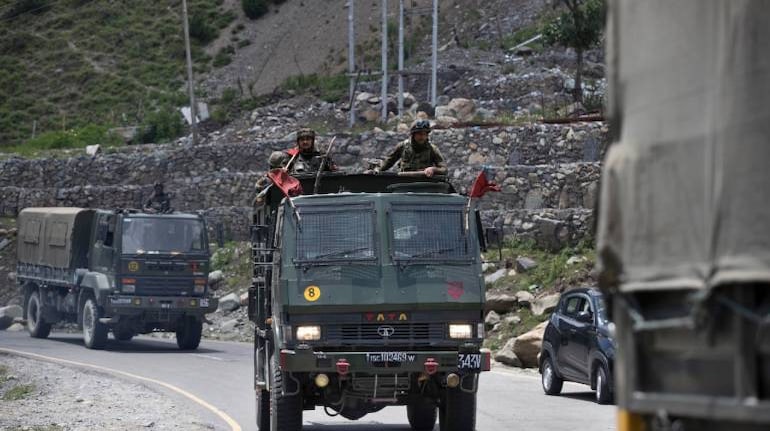| living with dragons: India's 2021 China policy |
| 送交者: 2021年01月03日05:33:30 于 [世界游戏论坛] 发送悄悄话 |
|
|
Living With Dragons: India’s 2021 China policy can’t be forged from hot words aloneIndia will need open-mind strategic reflection and creativity of the highest order to live in the dragon’s shadow.JANUARY 02, 2021 / 08:11 AM IST  Twenty Indian Army personnel including a colonel were killed in a fierce clash with Chinese troops in the Galwan Valley in eastern Ladakh on June 15 night, the biggest military confrontation in over five decades that has significantly escalated the already volatile border standoff in the region. Indian security forces said neither side fired any shots, instead throwing rocks and trading blows. This happened during the de-escalation process in Ladakh's Galwan Valley. Indians light candles to pay tributes to Indian soldiers killed during the confrontation with Chinese soldiers. (AP Photo/Mukhtar Khan)Flying the flags of Grand-Admiral Zheng He, 48 great ships of the line rounded the coast of Ceylon in February 1411. The 30,000 soldiers they bore had come to deliver the wrath of Zhu-Di, the third emperor of the Ming, who Ceylon’s king, Vira Alagakkonara, had refused to acknowledge as the son of heaven. “Their dens and hideouts we ravaged”, the scholar Timothy Brook records Zhu-Di’s advisor Yang Rong having written, “and made captive that entire country, bringing back to our August capital their women, children, families and retainers”. Zhu-Di left behind a stele introducing himself to the Buddha, the Vishnu of Tenamram and Allah, bearing the date 15 November, 1409: he was, it said, “The King of Great China, supreme overlord of kings, full-orbed moon in splendour”. He made generous offerings to the deities: A thousand qian of gold, 5,000 qian of silver, silk , scented oil and incense. Fei Xin, a soldier on the expedition, noted the outcome: “Now, the barbarians are respectful”. This New Year, that ancient war will seem strangely familiar to India’s strategic establishment. Even as Indian troops remain locked in a high-altitude standoff with the People’s Liberation Army in Ladakh, Beijing has expanded its influence across the region. In Nepal, where India’s status as regional hegemon was once unchallenged, Beijing has acquired not just economic influence, but real political heft. Bangladesh’s military relationship with the PLA Navy has expanded. President Mahinda Rajapaksa’s regime has sought to contain Indian influence in Sri Lanka. Although Beijing has slowed the pace of its investments in the China-Pakistan Economic Corridor, leaving Islamabad deeply dependent on Western aid, the deep strategic alliance between the two countries remains robust. Even in Bhutan, arguably India’s closest regional ally, many voices are arguing for a greater opening to China. The problems aren’t confined to India’s near-neighbourhood alone. Though angry words from European capitals on China’s human rights record enthused some in India, the reality is somewhat different. Brussels’ COVID-19-battered economies and Beijing have signed a new Free Trade Agreement that, in the view of many experts, gives the dragon far too many concessions. Even India’s closest allies in East Asia—among them, Japan and Australia—have signed on to the Regional Comprehensive Economic Partnership treaty, which will, inexorably, bind their economic destinies to those of China. In New Delhi’s foreign policy community, some hope President-elect Joseph Biden will move to contain China, delivering on the largely empty threats of his predecessor. They haven’t been listening, though, to the plain words of Biden’s closest advisors. “Trying to fully decouple, as some have suggested, from China”, incoming Secretary of State Antony Blinken said in a recent speech, “is unrealistic and ultimately counter-productive. It would be a mistake”. For Biden, growing racial tensions at home—coupled with the rage of the first youth cohort since the Great Depression to face the prospect of being poorer than its parents—are the principal issues he must confront as President. American greatness may be a warmth-inducing idea; it involves cold cash, though, that the United States is not going to be willing to bring to the table. President Biden’s administration may thus use punitive economic measures to dismantle unfair trade practices, or to signal displeasure at Chinese military aggression on its peripheries, but it is profoundly unlikely to enmesh itself in strategic conflict. Even in the event of the military coercion of Taiwan, extending to an actual invasion, few believe Biden would go to war. Lawrence Freedman, the great scholar of war, defined strategy thus: “identifying objectives; and about the resources and methods for meeting such objectives”. Faced with this bleak geopolitical landscape—and a strategic adversary whose economy, by some estimates, will overtake that of the United States by 2028—India’s China strategy has for the most been forged from hot words. Iron will, indomitable courage, and the will not to concede an inch of sovereign territory are all rousing ideas: Without a coherent strategy, though, they mean nothing. Three cold facts now ought to guide Indian thinking. First, fantasies that the dragon will be tied down by an alliance of the West need to be abandoned. The China-EU Agreement should make clear that, while the Western powers may deny access to some high-technology sectors, they are not considering a wider decoupling of their economies from China. The world is simply unwilling to follow India down the path of cutting itself off from China’s wealth. Secondly, this: India’s own military means are under severe strain. It is no secret that, for many years now, India’s defence budgets, as a percentage of Gross Domestic Product, have been the lowest since the war of 1962. The large bulk of that spending goes into meeting fixed liabilities like salaries, leaving little for modernisation—and thus widening the asymmetry with the PLA. There is little doubt the crippling impact of COVID-19 will increase these pressures: The Indian Navy, for example, has already deferred its hopes of building a 200-ship fleet, and slashed its acquisitions of a number of weapons systems.Illusions that India’s own weakness might be mitigated by alliances, thirdly, need to be abandoned. Even though regional states concerned at the existential threats they face might act to protect their own interests—it is even conceivable that Japan, South Korea and Australia seek independent nuclear deterrents—they will not take the risk of confronting the PLA on India’s behalf. New Delhi can reasonably hope its allies will assist with technology and weapons systems, as they have Taiwan; access to and absorption of those technologies will, however, be limited by India’s economic resources. In the long term, growing India’s economy will mitigate these problems—but the long term does nothing to solve India’s strategic problems today. Fighting back against China’s emergence as Asia’s preeminent power will, instead, require genuine strategic innovation. Instead of match the PLA’s gargantuan spending—an un-winnable competition even Taiwan’s cutting-edge military has long ago abandoned—Indian military strategists will need to ask themselves some hard questions. For example, it’s work questioning if the resources pumped into armoured formations set up to penetrate deep into Pakistan are still being spent wisely in times where nuclear weapons make such wars profoundly unlikely. Indian strategists need, moreover, to avoid being drawn into the kind of conflict the PLA might wish them to fight. Defending every inch of Indian territory is an idea that has acquired almost theological authority in Indian military minds. Yet, it has led, in the ongoing Ladakh standoff, to resources being committed to territory of no conceivable strategic value. The PLA, with its vastly superior logistical resources, can rapidly move in more troops along the middle sector this coming spring—tying down even more Indian soldiers, and bleeding the Army’s resources. Given these realities, it may also be worth carefully considering what a genuinely defensible line on India’s eastern borders might be—and preparing to wage short, sharp wars of attrition should it be violated. Liu Mingfu, a scholar at China’s National Defence University, estimated in a 2012 report that 70 percent of the PLA’s troops were only sons—a number rising to 80 percent among combat troops. Facing an adversary growing cohort of aged people, with ancient cultural norms against sending only sons to war, such a strategy might offer India greater deterrent heft at lower cost. Pitted against Megara in 161CE stood the mighty army of Antigonus II, his elephants lined up for the final, crushing assault on its walls. Then, the historian Polyaenus, “the Megarians daubed some swine with pitch, set fire to it, and let them loose among the elephants. The pigs grunted and shrieked under the torture of the fire, and sprang forwards as hard as they could among the elephants, who broke their ranks in confusion and fright, and ran off in different directions”. In war, victory doesn’t go to the strong, but the smart. For India to be able to live in the dragon’s shadow will need open-mind strategic reflection and creativity of the highest order. |
|
|
 |
 |
| 实用资讯 | |
|
|
| 一周点击热帖 | 更多>> |
| 一周回复热帖 |
| 历史上的今天:回复热帖 |
| 2020: | 特朗普“斩首”伊朗军官命令一出,美国 | |
| 2020: | 揭秘发动机单晶高温合金 国外已发展到第 | |
| 2019: | 畅玩国内应用 | |
| 2019: | 杂谈红楼: 皇上对贾家是皇恩浩荡 | |
| 2018: | 中国人不知道的历史----俄罗斯与蒙古的 | |
| 2018: | 起底莫迪:印度的法西斯,一个心狠手辣 | |
| 2017: | 有时候回复比正文更精彩 | |
| 2017: | 芝加哥去年枪击案增4成 特朗普责问市长 | |



